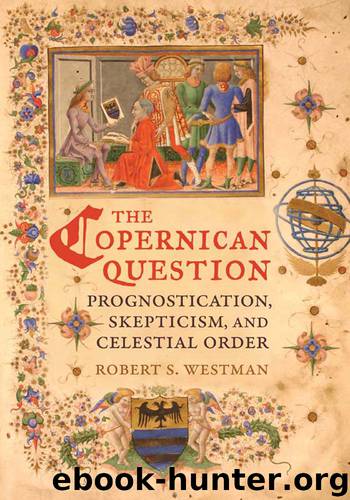Copernican Question by Westman Robert

Author:Westman, Robert
Language: eng
Format: epub
ISBN: 9780520948167
Publisher: University of California Press
The diurnal revolution of the Earth does not incite bodies along nor retard them: they neither outstrip the Earth’s motion nor fall behind when shot violently, whether to the east or to the west. Let EFG be the Earth, A the center, LE the ascending effluvia. As the orb of the effluvia moves with the Earth, so the part of the sphere on the right line LE proceeds undisturbed in the general rolling around.145 In LE the heavy body M falls perpendicularly to E, the shortest way toward the center; nor is this straight motion of the weight a composite motion or coacervated [i. e., mixed] with a circular motion, but rather simple and direct, never going out of the line LE. Indeed, a projectile shot with equal force from E toward F, and from E toward G, covers an equal distance in both directions, even as the Earth’s daily whirling around proceeds; and even as a man who takes twenty steps toward the east or the west covers an equal distance. Hence the Earth’s diurnal motion is not at all refuted by the illustrious Tycho Brahe through such arguments as these.146
Gilbert’s argument directly inverted Tycho’s interpretation of projectile motion on a moving Earth, going so far as to reject Copernicus’s formulation that such aggregated motions were made up of rectilinear and circular components.
Gilbert was thus clearly aware of the main issues from the roiling debates of the 1580s, even if he had no direct access to the local struggles in the Uraniborg-Kassel network. More difficult to assess is his position on the annual motion: “I pass by the Earth’s other movements, for here we treat only of the diurnal rotation, whereby it turns to the Sun and produces the natural day.”147
Did Gilbert intend to address “the Earth’s other movements” in another work? Or did he simply mean to refer to the precessional motion, treated in book 6, chapters 8 and 9? Logically, if the outermost sphere is deprived of any astronomical function, it is a short step to doing away with it altogether.148 Unlike Copernicus, Gilbert was clearly prepared to make that step. Moreover, the daily motion alone raised the well-known problem of explaining how bodies in free fall are not left behind. Having gone that far, it hardly seems sensible to say that Gilbert believed that he could offer final, formal and efficient causes for the diurnal rotation (to frame the matter in Aristotelian categories) but deliberately refused to extend such explanations to the annual revolution. Reasoning of this sort, joined with other considerations, has persuaded some interpreters that Gilbert must have been privately convinced of “the heliocentric universe,” possibly in Bruno’s version.149 But this reconstruction would imply that Gilbert, like Bruno, decided to ignore just the sorts of structural and ordering considerations that had so attracted Rheticus, Maestlin, Rothmann, and Kepler—or, at the very least, the Capellans Offusius and Naibod.150
Download
This site does not store any files on its server. We only index and link to content provided by other sites. Please contact the content providers to delete copyright contents if any and email us, we'll remove relevant links or contents immediately.
| Aeronautics & Astronautics | Astronomy |
| Astrophysics & Space Science | Comets, Meteors & Asteroids |
| Cosmology | Mars |
| Solar System | Star-Gazing |
| Telescopes | UFOs |
Tools of Titans by Timothy Ferriss(8294)
Turbulence by E. J. Noyes(7970)
Secrets of Antigravity Propulsion: Tesla, UFOs, and Classified Aerospace Technology by Ph.D. Paul A. Laviolette(5328)
Astrophysics for People in a Hurry by Neil DeGrasse Tyson(5147)
Room 212 by Kate Stewart(5063)
Design of Trajectory Optimization Approach for Space Maneuver Vehicle Skip Entry Problems by Runqi Chai & Al Savvaris & Antonios Tsourdos & Senchun Chai(5032)
Pale Blue Dot by Carl Sagan(4944)
The David Icke Guide to the Global Conspiracy (and how to end it) by David Icke(4650)
A Journey Through Divination and Astronomy by Publishing Pottermore(4361)
Goodbye Paradise(3757)
Apollo 8 by Jeffrey Kluger(3659)
COSMOS by Carl Sagan(3581)
Losing the Nobel Prize by Brian Keating(3514)
The Five People You Meet in Heaven by Mitch Albom(3513)
How to Read Water: Clues and Patterns from Puddles to the Sea (Natural Navigation) by Tristan Gooley(3427)
Brief Answers to the Big Questions by Stephen Hawking(3387)
How to Read Nature by Tristan Gooley(3286)
The Order of Time by Carlo Rovelli(3160)
A Brief History of Time by Stephen Hawking(2988)
